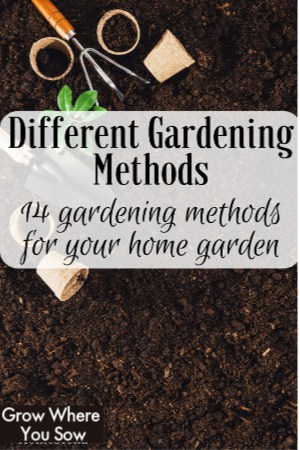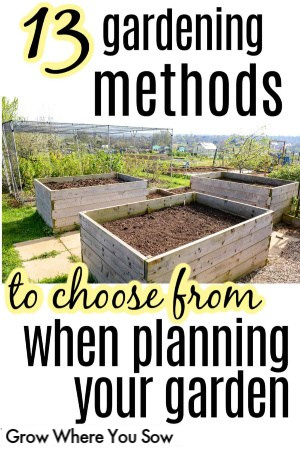Different gardening methods
If you’re planning to grow a victory garden, or gardens in general, one of the first steps is to decide on a method. With a handful of gardening methods to choose from, I’ve curated a list of the methods, including ones I’ve tried and found to work.

Table of contents
13 different gardening methods to choose from when designing your victory garden.
Container
Most folks who have limited space resort to container gardening, but it isn’t limited to just apartment homesteaders. ‘On The Green Acre Homestead, we’ve grown sweet potatoes, cilantro, kale, tomatoes, and cucumbers in container gardening (to name a few).
The perks of this method are you don’t have to tackle weeds, you can move them around and it doesn’t require as much soil. When I was in California, I helped my brother-in-law put together a beautiful terra cotta setup for his salad veggies and herbs. He’s had some success with both.
Strawbale
My husband lead our straw bale gardening days when we first moved in 4 years ago. I remember liking it, he says it was okay but the roots didn’t hold as well. If you do a quick search on the internet, gardening with this method can be successful if done right. By saying that, although our success wasn’t bountiful enough to remember I would still try it again.
Here’s the rundown:
Condition the straw bales with nitrogen fertilizer. Water in the fertilizer of choice, making sure to saturate every bale daily for several days. Add more fertilizer every couple of days, spreading it generously before soaking your bales again.
After your bales are saturated and fertilized, pull apart little holes for planting down the center of the bales, add potting mix plus compost and plant your seeds!
Raised bed
Since we live in Florida, raised beds have always been the best/easiest choice for us. Our yard is made up of 50% sand and 50% weeds. The beauty of gardening with raised beds is unlimited choices/layouts wrapped into this method. If you search “Raised Bed Gardening” on Pinterest, you’ll find 100’s of beautiful options. A simple setup can cost as little as $5-$10, depending on your material of choice and what you have on hand.
All you need is some type of weed barrier and a frame for your quality soil! Another perk with planting in raised beds is you’re not as limited in the crops you can plant. Additionally, the wood you buy should last years. We just replaced our original beds after 4 full years of planting in them.
A few things to note with raised beds:
- Contact your local county extensions office to receive a soil sample kit before planting.
- Be sure to practice companion planting and crop rotation with this gardening method, as it’ll yield the most optimum crop in years to come and cut down on pests.
- If using wood for the garden structure, untreated is the best.
- The deeper the garden bed, the more roots are encouraged to reach down, enhancing crop production and stability. The minimum requirement is 6 inches. For root crops (carrots, radishes) 12 inches is better.
Square foot gardening
The first time my husband and I grew a garden, we used the square foot gardening method. We bought the book and everything to make sure we did it right (we did). Our harvest was more bountiful than you can imagine, but we definitely invested the money to get it there.
The idea behind Square Foot Gardening is you divide your garden into 1-foot sections and plant within the squares, aiming to assist in creating a small but intensively planted garden.
The pros of this method:
- It cuts down on space. These gardens are great for mini garden spaces or apartments with a small backlot.
- Your plants will grow with vigor, supplying a steady harvest all season.
- If you properly build the garden with the soilless mix described in the book, maintenance will be minimal. Who likes pulling weeds all the time?
- The Square foot gardening method is a quick way to start a new garden and great for first-timers. You can build your bed anywhere —on grass, rock or pavement. This allows you to build, fill, and start planting in one day!
The cons of this method:
- There’s a high initial cost that can be off-putting. If you already have great soil to work with, use that instead of buying the specific mix recommended in the book. If you have an extra dime to spare, I would say try out the soilless mix!
- Small square foot garden beds aren’t ideal for larger crops, such as squash or zucchini, that take up a lot of room. With this method, you would want to stick to growing herbs and compact vegetables such as carrots, salad greens, or pole beans that you can trellis to vine up.
- The maintenance if you don’t stay on top of the weeds can be a real pain. If the weeds root down to the ground, you’ll have to put in a little back work to pull them out. You can avoid this by pulling them when they’re small!
We grew kale, spinach, tomatoes, lots of pole beans, and carrots to name a few. Two garden beds supplied us most of the veggies we wanted. I fully recommend this method.
Direct sow/In-Ground
There was a catch to this gardening method for me. Since I live in W. Central Fl., the soil here is just sand. When we moved into our home, the last owner left a wonderful pile of compost that we spread out over a small plot of land in order to plant (this was before we converted to raised beds). It was actually enough for a few inches of depth.
Eventually, that soil withered away and the sand wasn’t fertile enough to continue planting in so we invested in raised beds. Sowing in/on the ground is possible if you’re willing to prep your dirt or if you already have fertile soil. Send out a soil test through your local county extension office to see what you’re working with.
Trench/mound gardening
I know a couple who uses this method with great success. Every season or two, they turn the mounds over into what used to be the aisle/walkway. The cool thing about they way they used the trench/mount gardening method is they would compost all season in the aisles of the garden.
Once the season was over and they turned the planted pile onto the aisle, the aisle soil was nutrients rich. Other folks practice this method using plastic sheeting laid over their mounds, planting their crops in cut holes. Many larger farms practice gardening this way to significantly cut down on maintenance such as weeding.
Hügelkultur (my current method!)
I saved the best for last, friend. I just rebuilt our whole garden space. It’s been a long time coming as I’ve dreamed about having metal beds for years. A few months ago, I slowly started to acquire and invest in the materials I needed to have 3 ft deep, 4 ft wide and 8 ft long metal garden beds! Inside of these beds isn’t just soil, as I’m practicing the Hügelkultur method, a type of lasagna gardening if you will.
Traditionally, Hügelkultur is a garden bed mound constructed from decaying wood debris and other compostable organic plant materials, later planted as a raised bed. I’m taking a more modern approach and building my Hügelkultur bed inside of the metal beds I built.
The layers are (bottom to top):
- Decaying tree stumps, twigs, branches, etc.
- Carbon rich matter: old straw or hay, dried leaves and grass clippings
- Manure/compost/soil
Depending on how deep your garden is, you can repeat some of these.
My Hügelkultur garden bed layers are:
- Decaying tree stumps, twigs, branches, etc.
- Carbon rich matter: old straw or hay, dried leaves and grass clippings
- Manure/compost/soil
- More carbon rich material
- The soil from the gardens I replace
- Planting soil and compost mix
Alternative gardening methods:
These methods I haven’t personally used but have read about. Some of them I’m absolutely interested in and plan to try eventually.
- Vertical Gardening
- Just gardening up! Some pretty cool ideas on Pinterest for this!
- Just gardening up! Some pretty cool ideas on Pinterest for this!
- Hydroponic Gardening
- I’ve done the least amount of research on this gardening method but know people who use, and love it. Do your research before investing in a setup!
- I’ve done the least amount of research on this gardening method but know people who use, and love it. Do your research before investing in a setup!
- Aquaponic Gardening
- I love the idea behind aquaponics gardening. This method uses fish to recycle nutrition! Again, you’ll want to do some extensive research before setting up this method. Protip: There are ways you can make money on the side, also, with aquaponic gardening such as selling the offspring!
- I love the idea behind aquaponics gardening. This method uses fish to recycle nutrition! Again, you’ll want to do some extensive research before setting up this method. Protip: There are ways you can make money on the side, also, with aquaponic gardening such as selling the offspring!
- Lasagna Gardening
- A no-dig, no-till organic method resulting in rich, fluffy soil with very little work from you! From my small amount of research, this seems to go hand in hand with Hügelkultur.
- A no-dig, no-till organic method resulting in rich, fluffy soil with very little work from you! From my small amount of research, this seems to go hand in hand with Hügelkultur.
- Core Gardening
- Core gardening is, in short, and (too) simple of terms, when you put a nutrient-rich and moist core down the middle of your garden. I love the idea and have added it to my list of “try next”. You can, and should, read more about it here.
- Core gardening is, in short, and (too) simple of terms, when you put a nutrient-rich and moist core down the middle of your garden. I love the idea and have added it to my list of “try next”. You can, and should, read more about it here.
- Back to Eden
- I don’t know enough about this message to comment on it so, instead, I’ll direct you to this great post by Dana at Piwakawa Valley Homestead!
Have you used any of these gardening methods?
Square foot gardening can be a great way for beginning gardeners to grow vegetables and strawbale gardening is just super fun! Gardening is fun because everyone does it slightly differently than the other. What are you growing today?

